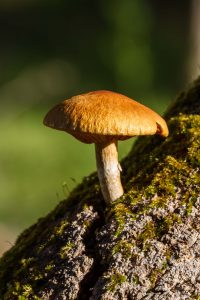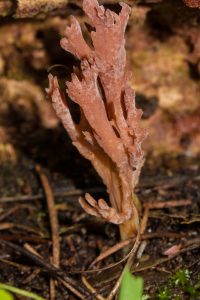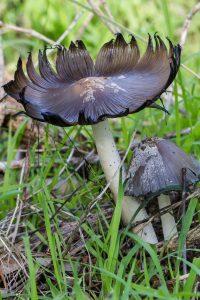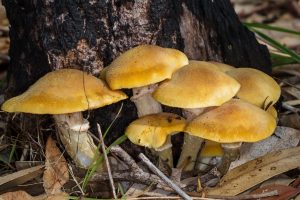The June excursion was a Fungi walk in Paganoni Reserve, Karnup.
Seven members and eight visitors attended the walk. It was especially pleasing to have so many visitors attend, having learned about the walk via the Internet. Our walk commenced at the main entrance off Paganoni Road and we headed towards the edge of the wetland to the west of the limestone track. The wetland is fringed by majestic Swamp Paperbarks (Melaleuca rhaphiophylla) and Gahnia trifida. We did not have to walk far before finding a range of fungi species taking advantage of fallen trunks and branches. With none of us claiming to be experts at identifying fungi the Perth Urban Fungi Field Guide on my iPad proved very useful, though there were a few specimens that we were unable to name, these included an unidentified Jelly Mould and an unidentified white mould.
Species that we spotted included Golden Wood Fungus (Gymnopilus allantopus), clusters of Clarke’s Pixy Cap (Mycena clarkeana), Slender Coral Fungus (Ramaria gracilis), Hairy Sterium (Stereum hirsutum), Scarlet Bracket (Pycnoporus coccineus), Scotsman’s Beard (Calocera guepinioides) – mainly on fallen Banksia trunks – and tiny parasols (Mycena sp.). Dung Buttons (Poronia erici) were present on a few Kangaroo droppings.
On the edge of the wetland we spotted West Australian Magpie Fungus (Coprinopsis aff. stangliana) and Erupting Russula (Russula erumpens). Eucalypt Crepidotus (Crepidotus eucalyptorum) was present on the trunk of a Tuart. After a brief pause for a cuppa and biscuits we crossed the limestone track to an area of Tuart woodland.
Here we found more Golden Wood Fungus and also a large cluster of Australian Honey Fungus (Armillaria luteobubalina) at the base of a burnt stump. The decaying remains of Ghost Fungus (Omphalotus nidiformis) were found but unfortunately no recently emerged specimens were spotted. In this area several Southern Diplolaena plants (Diplolaena dampieri) were in flower, both red and yellow flower variations. Surprisingly there were also a few Blue Laceflowers (Trachymene coerulea subsp. coerulea) that still had flowers out. We also spotted the entrance to an ant nest in the form of a volcanic crater, it was roughly 75mm in diameter and 50mm high and had been built one grain of sand at a time by tiny worker ants that were seen to be still toiling away. Other invertebrate sightings included a colourful hairy caterpillar on a Prickly Moses and an unusual Mud Wasp nest in the form of two cylindrical tubes found in amongst the paper bark of a Swamp Paperbark.
With our eyes looking downwards there was not much of an emphasis on developing a bird list. However birds that were sighted included Golden Whistler, Grey Shrike thrush, Scarlet Robin, Silvereyes, Inland Thornbill, Galahs, Australian Ringnecks, Red-capped Parrot, Black faced Cuckoo Shrike and Grey Fantail.
Other sightings included a large number of Midge Orchid (Cyrtostylis huegelii) leaves with buds in the wetland area that should result in a good display of flowers in coming weeks. After the main walk a few of us took a short walk to view a colony of Brown-veined Shell Orchids (Pterostylis aspera). Dark-banded Greenhoods (Pterostylis sanguinea) were also flowering at the same location.
Our morning walk had not covered much distance but our sightings in just a small area had demonstrated the diversity of fungi that is present in our urban bushland. It had been a very enjoyable morning.
Colin Prickett





